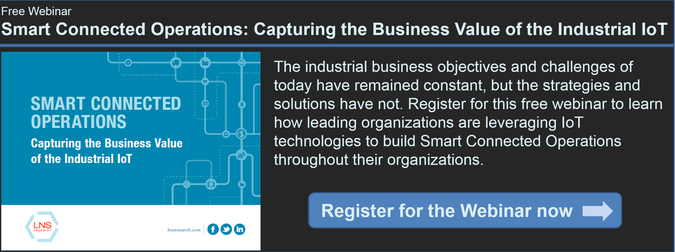Recent LNS Research cross-industry survey data tells us that almost 50% of respondents have no plans regarding implementation of the Industrial Internet of Things (IIoT).
This has been born out in our current Asset Performance Management (APM) survey as well, with less than 40% of the people leveraging the IIoT as a key element of the APM deployment. One of the most common cited reasons for not investing in smart devices is the classic mantra in manufacturing, “if it isn’t broken don’t fix it.” Manufacturers are notorious for running equipment for years beyond its originally projected life. In fact, the better the skills of the maintenance organization the more likely the equipment will continue to function well beyond its expected service life. However, this may not be the best strategy. With the proliferation of smart devices, the IIoT and the age of Smart Connected Assets now is the right time for many businesses to replace older not-so-smart technology.
We define Smart Connected Assets as those assets that are used by a business to produce and deliver its goods and services that can sense and respond to internal and external environments as an intelligent agent. This means they are aware of and can react to:
- Design & Configuration
- Past Performance
- Predicted Future Failure
- Raw Material
- Environmental Impact
- Other factors such as customer requirements or supplier performance
These assets are more than just digital sensors connected to a control system. Smart Connected Assets allow an enterprise to move beyond real-time control to predictive control and ultimately, autonomous operation.
Why Now?
Since relatively few companies have adopted the IIoT and are moving to Smart Connected Assets why is now the time to make the investment? Perhaps the most compelling reason is that today there is essentially no premium for digital devices with inherent connectivity. Contrast this quickly with the past, where smart devices with wireless connectivity commanded a steep price premium. Today, the R&D costs have been absorbed and the volumes have achieved levels such that it's sometimes cheaper to buy the smart wireless sensor than an older hard-wired analog or “dumb” digital sensor.
Another reason is that as the economy has improved the availability of capital to invest has improved. In fact, Chinese investments in modern technology are increasing at a faster rate than in most other areas. This is being driven by China’s desire to become not just the low cost producer of goods but to also become a world-class supplier of manufactured goods. It recognizes that the advantages offered by Smart Connected Assets as they relate to productivity and quality in particular can help it regain some of the competitiveness it has lost as wage differentials have eroded labor cost advantages. As other countries, notably the U.S. and those in Europe, have invested in automation to compete against the lower wage structure in Asia they've also reaped the benefits of Smart Connected Assets in quality and productivity, and now the Asian producers are investing to reduce those advantages. Therefore, further investment to stay out in front makes sense.
Perhaps the best reason to invest in Smart Connected Assets, however, is the ability to achieve Operational Excellence. Data from our APM survey indicates that over 50% of companies are investing in APM to drive operational performance improvements as their number one strategic objective and 80% have it as a top three objective. With so many companies focused on Operational Excellence yet not investing in the IIoT and Smart Connected Assets there is a disconnect that needs rectifying. The way to do that is to take advantage of the benefits Smart Connected Assets offer.
